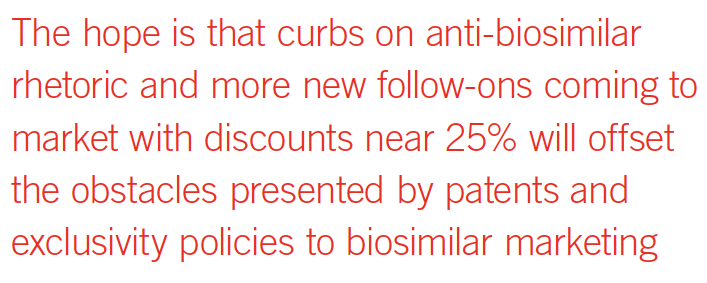Feds Target Biosimilar Anticompetitive Practices
Pharmaceutical Executive
Initiatives aim to limit the gamesmanship that can inhibit prescribing of follow-on biologics.
General disappointment over the slow pace of expanded market access to less costly biotech therapies has generated renewed efforts by FDA and other federal agencies to clarify policies and remove roadblocks to increased competition in the field. FDA has issued new guidance to support biosimilar development and approval, while also teaming up with the Federal Trade Commission (FTC) to counter negative messages
Jill Wechsler

from brands regarding biosimilar safety and effectiveness. While useful, these initiatives fail to alter the patent and exclusivity policies that create the main impediment to broader biosimilar uptake.
The 10th anniversary this month of enactment of the Biologics Price Competition and Innovation Act (BPCI) is focusing attention on the gains made since 2010 and main challenges ahead. FDA and sponsors are preparing to file and evaluate applications for follow-on versions of insulins as they now become eligible for licensing as biosimilar or interchangeable therapies. FDA held a public meeting in May 2019 to gain input on a streamlined approach to evaluating insulin follow-ons, particularly for combination products.
A positive sign is that the pace of FDA approvals of biosimilars has picked up in recent months, with more than 25 approved products as of early February and more than a dozen competitors on the market. In addition, the World Health Organization has begun to prequalify biosimilars of “essential medicines” approved in Europe and the US, making these treatments for serious conditions more available in less developed countries.
The FDA-FTC initiative takes aim at “misinformation” campaigns backed by brands to discourage prescribing and demand for biosimilars. In a joint statement, the two agencies outlined how they will work together to promote competitive markets for biological products to help Americans gain access to affordable medicines.1 Biological products “contribute significantly to drug costs,” noted FDA Commissioner Stephen Hahn, while FTC chairman Joseph Simons similarly observed that delays in making biosimilars available deprives patients of “lower prices and increased innovation.”
One specific goal for the two agencies is to help biosimilar makers gain ready access to samples of reference products needed to develop and test follow-ons-a difficulty that also has plagued the broader generic drug industry. FTC, furthermore, plans to take a close look at patent settlement agreements involving biologics and biosimilars to detect any antitrust violations.
This could involve brand rebate policies that discourage payers from providing financially attractive formulary placement and coverage of biosimilar products. A joint public workshop on March 9 discussed these collaborative efforts to advance biotech competition more fully.
Misinformation crackdown
In addition, FDA and FTC pledge to take “appropriate action” against false or misleading communications about biosimilars. Leading biosimilar makers Pfizer and Novartis have filed complaints with FDA about brand “scare tactics” that imply reduced safety and efficacy for biosimilars, and that patients may respond differently even to an approved follow-on.
FDA clarifies its policies for assuring that promotional messages by both brands and competitors are truthful, non-misleading, and balanced, as with all drug advertising, in draft guidance on promotional labeling and advertising for reference biologics and biosimilars issued in early February. The agency instructs brands to avoid implying in promotional materials that a reference product is safer or more effective than an approved biosimilar, or that the follow-on is “not highly similar” to the reference product, even if the competitor drug is not licensed for all indications.
The guidance emphasizes that a biosimilar product is not required to be identical to the brand to be licensed, but just that it be “highly similar” and without “clinically meaningful differences” in terms of safety, purity, and potency.
Another FDA guidance sets out a regulatory process for providing speedy reviews of biosimilars or interchangeable products when manufacturers seek to update an application to add indications to the label. As noted earlier, patent and exclusivity terms may prevent a newly licensed biosimilar from including all

indications of a reference product on the label, often for pediatric or orphan disease treatment.
But once those limitations expire, the follow-on manufacturer can file a supplemental application with data supporting the expanded indications.
The draft guidance clarifies how data and labeling should be presented in such cases and how the manufacturer may submit supplements to add previously omitted conditions of use.2 FDA says it will review such supplements within six months, much faster than the usual 10-month timeframe set for supplements to biologics license applications (BLAs).
With politicians on both sides of the aisle touting the importance of biosimilars for bolstering consumer access to less costly medicines, FDA is expected to continue to offer policy updates designed to facilitate product development. The hope is that curbs on anti-biosimilar rhetoric and more new follow-ons coming to market with discounts near 25% off reference prices will offset the obstacles presented by patents and exclusivity policies to biosimilar marketing.
Jill Wechsler is Pharmaceutical Executive’s Washington Correspondent. She can be reached at jillwechsler7@gmail.com
References

Navigating Distrust: Pharma in the Age of Social Media
February 18th 2025Ian Baer, Founder and CEO of Sooth, discusses how the growing distrust in social media will impact industry marketing strategies and the relationships between pharmaceutical companies and the patients they aim to serve. He also explains dark social, how to combat misinformation, closing the trust gap, and more.
Pfizer, GSK Gain ACIP Recommendations for RSV and Meningococcal Vaccines
April 18th 2025The Centers for Disease Control and Prevention’s Advisory Committee on Immunization Practices voted to expand access to Pfizer’s respiratory syncytial virus vaccine Abrysvo for high-risk adults in their 50s and voted in favor of GSK’s meningococcal vaccine, Penmenvy, for streamlined adolescent protection.